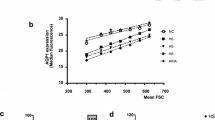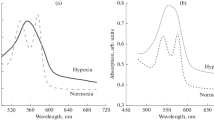Summary
In human red cells, Ca is mainly bound to the inner side of the plasma membrane. A smaller part may be present within intracellular Ca storing vesicles, while only a few percent of total red cell Ca is in ionized form. In some hemolytic anemias (sickle cell anemia,Β-thalassemia), an increased number of endocytotic vesicles storing Ca is probably responsible for the elevation of total red cell Ca content. Red cell Ca inward transport, which is partially susceptible to inhibition by Ca entry blockers, has been reported to be enhanced by physiological shear stress and enrichment in membrane cholesterol, as well as in some hemolytic anemias. Normal intracellular ionized Ca levels have been assessed in several diseases where elevated Ca inward transport rates or decreased Ca efflux through the Ca pump (hemolytic anemias, cystic fibrosis, essential hypertension) had been observed previously. Thus, red cell Ca homeostasis is apparently capable of keeping ionized Ca levels within the physiological range of 20–60 nM under most pathological conditions investigated so far.
Conceptually, changes in red cell Ca homeostasis (or also in other red cell membrane parameters) may be of pathophysiological importance in two respects:
-
1)
A disturbance may be directly responsible for some of the symptoms associated with a disease. This is the case in sickle cell anemia, where red cell dehydration is possibly caused by transient elevations of intracellular ionized calcium, which may activate K efflux through the Ca-activated K channel. The presence of dehydrated red cells will, in turn, lead to microvascular occlusion, a pathophysiologically important phenomenon in sickle cell anemia.
-
2)
A disturbance seen in erythrocytes or other blood cells such as platelets or lymphocytes may reflect similar phenomena in other cell types known to be involved in pathophysiological mechanisms. A widespread, generalized membrane defect has been proposed to be present in essential hypertension, causing an alteration of cellular Ca (and Na) homeostasis [35]. In some cell types, these alterations of Ca homeostasis may affect important Ca-dependent intracellular processes such as vascular smooth muscle contraction, transmitter release, or cell proliferation.
Similar content being viewed by others
Abbreviations
- ATP:
-
adenosine triphosphate
- Ca-ATPase:
-
calcium-adenosine triphosphatase
- DIDS:
-
4,4′-diisothiocyanatostilbene-2,2′-disulfonic acid
- HDL:
-
high density lipoprotein
- NMR:
-
nuclear magnetic resonance
- UEA1 :
-
Ulex europaeus agglutinin I
References
Al Jobore A, Minocherhomjee AM, Villalobo A, Roufogalis BD (1984) Active calcium transport in normal and abnormal human erythrocytes. In: Kruckeberg WC, Eaton JW, Aster J, Brewer GJ (eds) Erythrocyte membranes 3: recent clinical and experimental advances. Liss, New York, pp 243–292
Bookchin RM, Lew VL (1980) Progressive inhibition of the Ca pump and Ca:Ca exchange in sickle red cells. Nature 284:561–563
Bookchin RM, Ortiz OE, Shalev O, Tsurel S, Rachmilewitz EA, Hockaday A, Lew VL (1988) Calcium transport and ultrastructure of red cells in beta-thalassemia intermedia. Blood 72:1602–1607
Bookchin RM, Ortiz OE, Lew VL (1989) Mechanisms of red cell dehydration in sickle cell anemia. Application of an integrated red cell model. In: Raess BU, Tunnicliff G (eds) The red cell membrane. A model for solute transport. Humana Press, Clifton, NJ, pp 443–461
Dagher G, Amar M, Khefif A (1987) Red blood cell's Ca2+ pump is not altered in essential hypertension of humans and Kyoto rats. Biochim Biophys Acta 903:218–228
De la Sierra A, Hannaert P, Ollivier J-P, Senn N, Garay R (1990) Kinetic study of the Ca+ pump in erythrocytes from essential hypertensive patients. J Hypertension 8:285–293
Eaton JW, Skelton TD, Swofford HS, Kolpin CE, Jacob HS (1973) Elevated erythrocyte calcium in sickle cell disease. Nature 246:105–106
Engelmann B, Duhm J (1986) Total intracellular calcium content and sodium transport in erythrocytes of essential hypertensive patients. J Hypertension 4 [Suppl 6]:S324-S327
Engelmann B, Duhm J (1987) Intracellular calcium content of human erythrocytes: relation to sodium transport systems. J Membr Biol 98:79–87
Engelmann B, Duhm J (1989) Distinction of two components of passive Ca2+ transport into human erythrocytes by Ca2+ entry blockers. Biochim Biophys Acta 981:36–42
Engelmann B, Grevers G, Janka HU, Duhm J (1990) Alterations in Na+, K+ and Ca2+ transport in erythrocytes of patients with carcinomas of the head and neck: possible role of mild anemia and cell age. Clin Sci 78:315–320
Engelmann B, Schumacher U, Duhm J (1990) Use of chlortetracycline fluorescence for the detection of Ca storing intracellular vesicles in normal human erythrocytes. J Cell Physiol 143:357–363
Engelmann B, Schumacher U, Duhm J (1991) Role of ABH blood group antigens in the stimulation of a DIDS-sensitive Ca++ influx pathway in human erythrocytes by Ulex europaeus agglutinin I and a monoclonal anti A1 antibody. Biochim Biophys Acta (in press)
Ferreira HG, Lew VL (1977) Passive Ca transport and cytoplasmic Ca buffering in intact red cells. In: Ellory JC, Lew VL (eds) Membrane transport in red cells. Academic Press, London, pp 53–91
Gárdos G (1956) The permeability of human erythrocytes to potassium. Acta Physiol Acad Sci Hung 10:185–189
Gopinath RM, Vincenzi FF (1979) (Ca2+ +Mg2+)-ATPase activity of sickle cell membranes: decreased activation by red blood cell cytoplasmic activator. Am J Hematol 7:303–312
Harrison DG, Long C (1968) The calcium content of human erythrocytes. J Physiol 199:367–381
Larsen FL, Katz S, Roufogalis BD, Brooks DE (1981) Physiological shear stresses enhance the Ca2+ permeability of human erythrocytes. Nature 294:667–668
Lew VL, Tsien RY, Miner C, Bookchin RM (1982) Physiological Ca 2+i level and pump-leak turnover in intact red cells measured using an incorporated Ca chelator. Nature 298:478–481
Lew VL, Hockaday A, Sepulveda MI, Somlyo AP, Somlyo AV, Ortiz OE, Bookchin RM (1985) Compartmentalization of sickle-cell calcium in endocytic inside-out vesicles. Nature 315:586–589
Lichtman MA, Weed RI (1972) Divalent cation content of normal and ATP-depleted erythrocytes and erythrocyte membranes. Nouv Rev Fr Hemat 12:799–814
McNamara MK, Wiley JS (1986) Passive permeability of human red blood cells to calcium. Am J Physiol 250 (Cell Physiol 19):C26-C31
Morris MJ, David-Dufilho M, Devynck MA (1988) Red blood cell ionized calcium concentration in spontaneous hypertension: modulation in vivo by the calcium antagonist PN 200.110. Clin Exp Pharmacol Physiol 15:257–260
Murphy E, Levy L, Berkowitz LR, Orringer EP, Gabel SA, London RE (1986) Nuclear magnetic resonance measurement of cytosolic free calcium levels in human red blood cells. Am J Physiol 251:C496-C504
Murphy E, Berkowitz LR, Orringer E, Levy L, Gabel SA, London RE (1987) Cytosolic free calcium levels in sickle red blood cells. Blood 69:1469–1474
Neyses L, Locher R, Stimpel M, Streuli R, Vetter W (1985) Stereospecific modulation of the calcium channel in human erythrocytes by cholesterol and its oxidized derivatives. Biochem J 227:105–112
Niggli V, Adunyah ES, Cameron BF, Bababunmi EA, Carafoli E (1982) The Ca2+-pump of sickle cell plasma membranes. Purification and reconstitution of the ATPase enzyme. Cell Calcium 3:131–151
Nomoto S, Shoji SI (1987) Optimized atomic absorption spectrophotometry of calcium in erythrocytes. Clin Chem 33:2004–2007
O'Rear EA, Udden MM, McIntire LV, Lynch EC (1981) Problems in measurement of erythrocyte calcium. Am J Hematol 11:283–292
Orlov SN, Pokudin NI, Postnov YV (1983) Calmodul-independent Ca2+ transport in erythrocytes of spontaneously hypertensive rats. Pflügers Arch 397:54–56
Paschen K, Henning HV, Quellhorst E, Scheler F (1971) VerÄnderungen der Calcium- und Magnesium-Konzentrationen im Plasma und in Erythrozyten wÄhrend der HÄmodialyse. Klin Wochenschr 49:1314–1318
Penner R, Matthews G, Neher E (1988) Regulation of calcium influx by second messengers in rat mast cells. Nature 334:499–504
Postnov YV, Orlov SN, Pokudin NI (1979) Decrease of calcium binding by the red blood cell membrane in spontaneously hypertensive rats and in essential hypertension. Pflügers Arch 379:191–195
Postnov YV, Orlov SN, Reznikova MB, Rjazhsky GG, Pokudin NI (1984) Calmodulin distribution and Ca2+ transport in the erythrocytes of patients with essential hypertension. Clin Sci 66:459–463
Postnov YV, Orlov SN (1985) Ion transport across plasma membrane in primary hypertension. Physiol Rev 65:904–945
Rhoda MD, Giraud F, Craescu CT, Benzard Y (1985) Compartmentalization of Ca2+ in sickle cells. Cell Calcium 6:397–411
Rhoda MD, Galacteros F, Benzard Y, Giraud F (1987) Ca2+ permeability and cytosolic Ca2+ concentration are not impaired inΒ-thalessemic and hemoglobin C erythrocytes. Blood 70:804–808
Rhoda MD, Aporo M, Benzard Y, Giraud F (1990) Ca2+ permeability in deoxygenated sickle cells. Blood 75:2453–2458
Rosier F, M'Zali H, Giraud F (1986) Cholesterol depletion affects the Ca2+ influx but not the Ca2+ pump in human erythrocytes. Biochim Biophys Acta 863:253–263
Scharff O (1981) Calmodulin and its role in cellular activation. Cell Calcium 2:1–27
Scharff O, Foder B (1989) Calcium fluxes in pathologically altered red cells. In: Raess BU, Tunnicliff G (eds) The red cell membrane. A model for solute transport. Humana Press, Clifton, NJ, pp 423–442
Schatzmann HJ (1966) ATP dependent Ca2+ extrusion from human red cells. Experientia 22:364–368
Schatzmann HJ (1986) The plasma membrane calcium pump. In: Bader H, Gietzen K, Rosenthal J, Ruedel R, Wolf HU (eds) Intracellular calcium regulation. Manchester University Press, Manchester, pp 47–56
Shalev O, Mogilner S, Shinar E, Rachmilewitz EA, Schrier SL (1984) Impaired erythrocyte calcium homeostasis inΒthalessemia. Blood 64:564–566
Shiga T, Sekiya M, Maeda N, Kon K, Okazaki M (1985) Cell age-dependent changes in deformability and calcium accumulation of human erythrocytes. Biochim Biophys Acta 814:289–299
Stimpel M, Neyses L, Locher R, Knorr M, Vetter W (1985) High density lipoproteins — modulators of the calcium channel? J Hypertension 3 [Suppl 3]:S49-S51
Tiffert T, Spirak JL, Lew VL (1988) Magnitude of calcium influx required to induce dehydration of normal human red cells. Biochim Biophys Acta 943:157–165
Turrini F, Naitana A, Mannuzzu L, Pescarmona G, Arese P (1985) Increased red cell calcium, decreased calcium adenosine triphosphatase, and altered membrane proteins during fava bean hemolysis in glucose-6-phosphate dehydrogenase-deficient (Mediterranean variant) individuals. Blood 66:302–305
Varecka L, Carafoli E (1982) Vanadate induced movements of Ca2+ and K+ in human red blood cells. J Biol Chem 257:7414–7421
Waller RL, Johnson LR, Brattin WJ, Dearborn DG (1985) Erythrocyte cytosolic free Ca2+ and plasma membrane Ca2+ -ATPase activity in cystic fibrosis. Cell Calcium 6:245–264
Wehling M, Vetter W, Neyses L, Groth H, Boerlin HJ, Locher R, Siegenthaler W, Kuhlmann U (1983) Altered calcium and sodium metabolism in red blood cells of hypertensive man: assessment by ion-selective electrodes. J Hypertension 1:171–176
Wiley JS, McCulloch KE, Bowden DS (1982) Increased calcium permeability of cold-stored erythrocytes. Blood 60:92–98
Yoshida M, Tada Y, Kasahara Y, Ando K, Satoyoshi E (1986) Ca content of human erythrocytes. What is the true value? Cell Calcium 7:169–174
Zidek W, Losse H, Dorst KG, Zumkley H, Vetter H (1982) Intracellular sodium and calcium in essential hypertension. Klin Wochenschr 60:859–862
Author information
Authors and Affiliations
Rights and permissions
About this article
Cite this article
Engelmann, B. Calcium homeostasis of human erythrocytes and its pathophysiological implications. Klin Wochenschr 69, 137–142 (1991). https://doi.org/10.1007/BF01665851
Received:
Accepted:
Issue Date:
DOI: https://doi.org/10.1007/BF01665851




